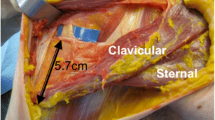Abstract
Objective
Improvement of shoulder mobility and of strength of the upper limb.
Alleviation of pain.
Indications
Massive tears not amenable to repair by suture.
Contraindications
Tendinous defect of subscapularis.
Loss of function of deltoid.
Advanced osteoarthritis of glenohumeral joint.
Surgical Technique
Preparation of a distally pedicled muscle flap of the latissimus dorsi. Acromioplasty in presence of a caudally pointing spur. Resection of the acromioclavicular joint, if indicated. Mobilization of the remaining medial stump of the rotator cuff. Tenotomy and tenodesis of the long head of the biceps. The tendon of the muscle flap is passed between posterior part of deltoid and posterocranial part of the cuff into the defect area and sutured to healthy tissue of the remaining cuff.
Results
Between 1986 and 1989 we performed this technique in 16 patients (one woman, 15 men) and followed them up for an average of 33 months. The patients’ average age was 60 (39–75) years. Postoperatively, a marked reduction in pain was noted as well as an improvement of shoulder function; the age-adjusted Constant score amounted to 73 (35–97) points.
Aspiration of a sterile fluid collection became necessary in one patient. In another patient in whom a torn subscapularis had been repaired, a revision surgery had to be performed on account of persisting pain and insufficiency of the subscapularis muscle. A further patient needed a subsequent resection of the acromioclavicular joint due to persistent pain.
Similar content being viewed by others
References
Borgeat A, Tewes E, Biasca N, Gerber C. Patient-controlled inters-calene analgesia with ropivacaine after major shoulder surgery: PCIA vs PCA. Br J Anaesth 1998;81:603–5.
Constant CR, Murley AH. A clinical method of functional assessment of the shoulder. Clin Orthop 1987:214:160–4.
Gerber C. Latissimus dorsi transfer for the treatment of irreparable tears of the rotator cuff. Clin Orthop 1992;275:152–60.
Gerber C, Krushell RJ. Isolated rupture of the tendon of the subscapularis muscle. Clinical features in 16 cases. J Bone Joint Surg Br 1991;73:389–94.
Gerber C, Vinh TS, Hertel R, Hess CW. Latissimus dorsi transfer for the treatment of massive tears of the rotator cuff. A preliminary report. Clin Orthop 1988;232:51–61.
Gerber C, Schneeberger AG, Beck M, Schlegel U. Mechanical strength of repairs of the rotator cuff. J Bone Joint Surg Br 1994; 76:371–80.
Goutallier D, Postel JM, Bernageau J, Lavau L, Voisin MC. Fatty muscle degeneration in cuff ruptures. Pre- and postoperative evaluation by CT scan. Clin Orthop 1994;304:78–83.
Hertel R, Lambert SM, Ballmer FT. The deltoid extension lag sign for diagnosis and grading of axillary nerve palsy. J Shoulder Elbow Surg 1998;7:97–9.
Warner IP, Krushell RJ, Masquelet AC, Gerber C. Anatomy and relationships of the suprascapular nerve: anatomical constraints to mobilization of the supraspinatus and infraspinatus muscles in the management of massive rotator-cuff tears. J Bone Joint Surg Am 1992;74:36–45.
Zanetti M, Gerber C, Hodler J. Quantitative assessment of the muscles of the rotator cuff with magnetic resonance imaging. Invest Radiol 1998;33:163–70.
Author information
Authors and Affiliations
Corresponding author
Rights and permissions
About this article
Cite this article
Thomann, S.R., Dumont, C.E. & Gerber, C. The Latissimus Dorsi Transfer for Treatment of Massive Rotator Cuff Tears. Orthop Traumatol 9, 149–158 (2001). https://doi.org/10.1007/s065-001-8349-5
Published:
Issue Date:
DOI: https://doi.org/10.1007/s065-001-8349-5




